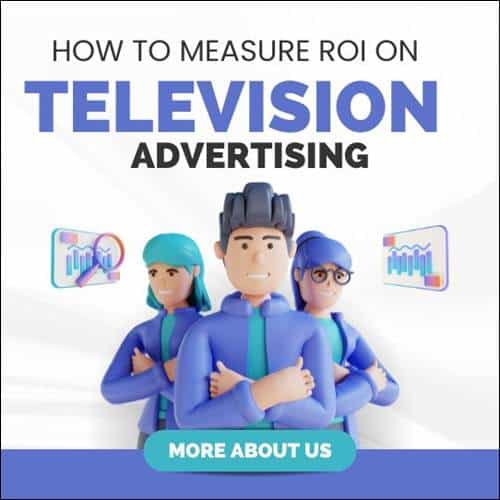
In the field of marketing, television advertising has long been a mainstay. Because of its unmatched ability to reach a wide range of audiences, businesses wishing to market their goods or services frequently turn to social media. However, calculating the return on investment (ROI) of television commercials can be a difficult task in the digital age, when data-driven marketing methods are king.
So continue reading if you’ve ever wondered how to evaluate the effectiveness of your TV commercials and if your advertising budget is being well spent. We’ll reveal the tactics, KPIs, and actual case studies that will assist you in deciphering the mysteries of ROI measurement for television advertisements. Regardless of your level of experience, this post will give you insightful knowledge about this dynamic field so you can maximize the returns on your television advertising expenditures and make more data-driven choices.
Let’s start with understanding the foundations of television advertising and why analyzing its ROI is vital in today’s marketing landscape.
The Basics of Television Advertising:
One reliable way to reach a large audience is through television advertising. You may interact with potential customers in their living rooms with a well-made television advertisement, building brand awareness and increasing sales. Common forms of television advertising include sponsorships, product placements, infomercials, and commercials, each having its own advantages and tactics.
The cost of television advertising might vary dramatically. The cost depends on a number of variables, including the production quality, channel, and time slot. Even though it can be expensive, television advertising frequently justifies the expenditure due to its effect and reach.
The concept of ROI:
In business and advertising, return on investment, or ROI, is a key idea. It calculates the return on investment for an investment, in this example, your TV ad campaign. A campaign that has a positive return on investment (ROI) is making more money than it is spending; one that has a negative ROI suggests the opposite.
ROI is an important measure since it helps companies evaluate how well their advertising initiatives are working. You’re essentially operating in the dark without knowing whether your marketing efforts are producing the expected outcomes if you don’t measure ROI.
Challenges in Determining the ROI of TV Ads:
There are several difficulties in measuring return on investment (ROI) for television advertising, especially in the current digital environment. These are a few of the main challenges:
Delayed Responses: TV advertising can have a delayed effect, in contrast to digital advertising, which frequently yields rapid results. Even after watching your TV advertisement, some people decide not to buy right away.
Brand recognition: One important long-term benefit of television advertising is its ability to increase brand recognition. However, because a variety of factors affect consumer behavior, it might be difficult to accurately attribute sales to a TV advertisement.
Traditional Measurement Limitations: Surveys and focus groups are two examples of traditional techniques for measuring the return on investment (ROI) of TV ads. They might not offer the data-driven, real-time insights that companies are
Effective Strategies for Measuring ROI on Television Advertisement:
Consider the following tactics in order to accurately gauge the return on investment of television advertising:
Establish Specific Goals: To begin, decide on precise goals for your campaign. Having clearly stated goals is essential, regardless of the objective—boosting sales, increasing website traffic, or raising brand awareness.
Employ specialized tracking systems: Incorporate distinctive monitoring methods into your TV advertisements, such as certain dedicated phone numbers. This enables you to link certain reactions to your TV advertising strategy.
A/B testing and control groups: Use A/B testing to assess how well various ad creatives or time slots perform. You can ascertain baseline performance without the impact of TV advertisements by using control groups.
Leverage Data Analytics: Track customer behavior across multiple touchpoints by utilizing technology and data analytics. You can better comprehend the consumer experience and the place of TV advertising in it with the aid of data-driven insights.
Key Performance Indicators (KPIs) for TV Advertisement ROI:
KPIs, or key performance indicators, are crucial criteria for calculating return on investment. The following KPIs are pertinent to TV ad campaigns:
Reach: Measure the number of individuals your advertisement reached. This shows the possible exposure of the audience.
Conversion rate: Determine the conversion rates for all forms of traffic, including internet purchases, lead generation, and foot traffic to physical stores.
Customer acquisition cost: Calculate your customer acquisition cost (CAC) to find out how much it costs to bring in a new client via a television advertising campaign.
Customer Lifetime Value (CLV): Evaluate the long-term benefits that your company receives from customers who you brought in with your TV advertisements.
Tools and Resources:
Use tools and services like the following to help you determine the return on investment (ROI) of your TV ads:
Google Analytics: For tracking online conversions and website traffic.
Call Tracking Software: To monitor phone call responses.
Media Mix Modeling: For advanced statistical analysis of the impact of various advertising channels
Industry Research Reports: To gain insights into TV advertising trends and benchmarks.
Conclusion
In conclusion, measuring the ROI of television advertising is a challenging but essential endeavor. Understanding the basics of television advertising, the concept of ROI, and the hurdles associated with measurement can help you navigate this complex landscape. By implementing effective measurement strategies, focusing on key performance indicators, and studying real-world case studies, you can gain insights into the impact of your TV ads. As technology and data analytics continue to advance, businesses are better equipped than ever to measure the ROI of their television advertising efforts. In an era where data is king, harnessing the power of television advertising and accurately measuring its ROI can be a game-changer for your business. Make informed decisions, optimize your TV ad campaigns, and ensure that your advertising dollars are put to good use.
Leave a Reply
You must be logged in to post a comment.